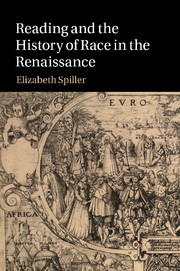Book contents
- Frontmatter
- Contents
- Acknowledgements
- Introduction: Print Culture, the Humoral Reader, and the Racialized Body
- 1 Genealogy and race after the Fall of Constantinople: From The King of Tars to Tirant lo Blanc and Amadis of Gaul
- 2 The form and matter of race: Aethiopika, hylomorphism, and neo-Aristotelian readers
- 3 The conversion of the reader: Ariosto, Herberay, Munday, and Cervantes
- 4 Pamphilia's black humor: reading and racial melancholy in the Urania
- Notes
- Index
1 - Genealogy and race after the Fall of Constantinople: From The King of Tars to Tirant lo Blanc and Amadis of Gaul
Published online by Cambridge University Press: 01 June 2011
- Frontmatter
- Contents
- Acknowledgements
- Introduction: Print Culture, the Humoral Reader, and the Racialized Body
- 1 Genealogy and race after the Fall of Constantinople: From The King of Tars to Tirant lo Blanc and Amadis of Gaul
- 2 The form and matter of race: Aethiopika, hylomorphism, and neo-Aristotelian readers
- 3 The conversion of the reader: Ariosto, Herberay, Munday, and Cervantes
- 4 Pamphilia's black humor: reading and racial melancholy in the Urania
- Notes
- Index
Summary
In his influential rereading of Northrup Frye and Erich Auerbach's accounts of the structure of identification that defines romance, Fredric Jameson argues that the genre is structured as much by difference as it is by recognition and identification. For Jameson:
Romance in its original strong form may then be understood as an imaginary “solution” to this real contradiction, a symbolic answer to the perplexing question of how my enemy can be thought of as being evil (that is, as other than myself and marked by some absolute difference) when what is responsible for his being so characterized is quite simply the identity of his own conduct with mine.
As Jameson stresses, romance is predicated upon a commitment to the twin beliefs that the identity of the enemy is visibly “marked by some absolute difference” and yet that your identity is nonetheless ultimately indistinguishable from theirs. The seeming fixity and absoluteness of identity that characterizes romance also paradoxically demands a correlative fluidity of identity that stands against and alongside that fixity. Within romance, you need to be able to recognize the other less because of his utter difference than because his identity is some version of yours. In the material form of this demand for visible difference, the “black knight” is the enemy only so long as he wears his armor; when he puts that off and reveals his name, the knight who was the enemy becomes a version of the knight himself and must do so for both the social and moral structure of romance to work.
- Type
- Chapter
- Information
- Reading and the History of Race in the Renaissance , pp. 41 - 78Publisher: Cambridge University PressPrint publication year: 2011



